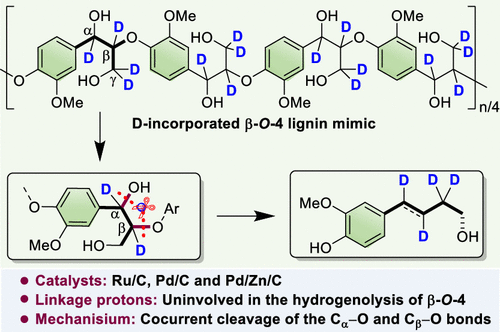当前位置:
X-MOL 学术
›
ACS Catal.
›
论文详情
Our official English website, www.x-mol.net, welcomes your
feedback! (Note: you will need to create a separate account there.)
Paving the Way for the Lignin Hydrogenolysis Mechanism by Deuterium-Incorporated β-O-4 Mimics
ACS Catalysis ( IF 11.3 ) Pub Date : 2020-09-23 , DOI: 10.1021/acscatal.0c02339 Helong Li 1 , Guoyong Song 1
ACS Catalysis ( IF 11.3 ) Pub Date : 2020-09-23 , DOI: 10.1021/acscatal.0c02339 Helong Li 1 , Guoyong Song 1
Affiliation

|
Gaining more insight into the lignin hydrogenolysis mechanism is of great importance for developing next-generation catalysts and regulating product distribution because lignin is the only renewable aromatic source leading to aromatic chemicals. However, the inherent complexity of the lignin structure and the multiple pathways in lignin hydrogenolysis make gaining insight into the lignin hydrogenolysis mechanism even more challenging. In this report, a β-O-4 polymer with deuterium incorporated at the α, β, and γ positions which can better model the plant lignin structure was prepared for mechanistic study. The location and retention of deuterium in the monomers resulting from the hydrogenolysis and transfer hydrogenolysis of the deuterated β-O-4 mimics with Ru/C, Pd/C, and Pd/Zn/C in MeOH indicated that the β-O-4 linkage protons did not participate in the cleavage process, which indicated that pathways involving dehydrogenation and/or dehydration reactions are infeasible for these catalysts under these conditions. A concerted process, wherein the Cα–O and Cβ–O bonds in β-O-4 structures were cleaved concurrently, was proposed as a potential hydrogenolysis mechanism in the Pd/C and Ru/C systems. Dehydroxylation at the α position was identified as a side reaction in the Pd/C-catalyzed hydrogenolysis of dimer models, from which the same concurrent cleavage mechanism was also inferred. The introduction of a Lewis acid center in Pd/C was conducive to β-O-4 hydrogenolysis, as confirmed by the abatement of the side reaction and the enhanced monomer yield in the polymeric model reactions. The use of deuterium-incorporated β-O-4 mimics paved the way for clearly elucidating the lignin hydrogenolysis mechanism.
中文翻译:

掺氘的β-O-4模拟物为木质素氢解机理铺平道路
对木质素氢解机理的更多了解对于开发下一代催化剂和调节产品分布非常重要,因为木质素是导致芳香族化学物质的唯一可再生芳香族来源。然而,木质素结构固有的复杂性以及木质素氢解的多种途径使得对木质素氢解机理的深入了解更具挑战性。在该报告中,制备了可以更好地模拟植物木质素结构的在α,β和γ位置掺入氘的β-O-4聚合物用于机理研究。氘在β-O-4模拟物中用Ru / C,Pd / C进行氢解和转移氢解后,氘在单体中的位置和保留 甲醇中的Pd / Zn / C和Pd / Zn / C表明,β-O-4键合质子不参与裂解过程,这表明在这些条件下,涉及这些催化剂的脱氢和/或脱水反应的途径是不可行的。一个协调的过程,其中Cα -O和C β在β-O-4 -O键的结构是在同时裂解,提出了如在钯/ C和Ru / C系统的电位氢解机制。在Pd / C催化的二聚体氢解反应中,α位的脱羟基反应被认为是副反应,由此也可以推断出相同的同时裂解机理。在Pd / C中引入路易斯酸中心有利于β-O-4氢解,这可以通过减少副反应和提高聚合物模型反应的单体收率来证实。掺氘的β-O-4模拟物的使用为清楚阐明木质素氢解机理铺平了道路。
更新日期:2020-10-17
中文翻译:

掺氘的β-O-4模拟物为木质素氢解机理铺平道路
对木质素氢解机理的更多了解对于开发下一代催化剂和调节产品分布非常重要,因为木质素是导致芳香族化学物质的唯一可再生芳香族来源。然而,木质素结构固有的复杂性以及木质素氢解的多种途径使得对木质素氢解机理的深入了解更具挑战性。在该报告中,制备了可以更好地模拟植物木质素结构的在α,β和γ位置掺入氘的β-O-4聚合物用于机理研究。氘在β-O-4模拟物中用Ru / C,Pd / C进行氢解和转移氢解后,氘在单体中的位置和保留 甲醇中的Pd / Zn / C和Pd / Zn / C表明,β-O-4键合质子不参与裂解过程,这表明在这些条件下,涉及这些催化剂的脱氢和/或脱水反应的途径是不可行的。一个协调的过程,其中Cα -O和C β在β-O-4 -O键的结构是在同时裂解,提出了如在钯/ C和Ru / C系统的电位氢解机制。在Pd / C催化的二聚体氢解反应中,α位的脱羟基反应被认为是副反应,由此也可以推断出相同的同时裂解机理。在Pd / C中引入路易斯酸中心有利于β-O-4氢解,这可以通过减少副反应和提高聚合物模型反应的单体收率来证实。掺氘的β-O-4模拟物的使用为清楚阐明木质素氢解机理铺平了道路。

































 京公网安备 11010802027423号
京公网安备 11010802027423号